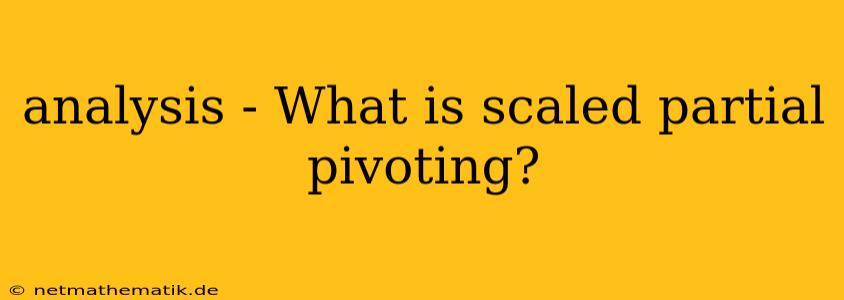Understanding Scaled Partial Pivoting in Linear Algebra
Solving systems of linear equations is a fundamental task in various fields like engineering, physics, and economics. Gaussian elimination, a popular method for solving such systems, often requires pivoting to ensure numerical stability and accuracy. One pivotal strategy, scaled partial pivoting, plays a crucial role in enhancing the robustness of Gaussian elimination. This article delves into the concept of scaled partial pivoting, exploring its mechanics, benefits, and applications.
What is Scaled Partial Pivoting?
Pivoting in Gaussian Elimination
Gaussian elimination systematically transforms a system of linear equations into an upper triangular form, allowing for straightforward back-substitution to obtain the solution. However, during this process, dividing by a small pivot element (the leading coefficient in a row) can amplify round-off errors, potentially leading to inaccurate results. Pivoting aims to mitigate this by selecting a suitable pivot element.
The Role of Scaled Partial Pivoting
Scaled partial pivoting is a specific pivoting strategy that aims to select the pivot element based on its scaled magnitude. This scaling ensures that the pivot element is not only the largest in its column but also considered relative to the size of the other elements in the row. This approach helps to minimize the potential for numerical instability.
How It Works
-
Scaling: For each row in the augmented matrix representing the system of equations, divide each element by the absolute value of the largest element in that row. This creates a scaled row where all elements have magnitudes less than or equal to 1.
-
Column Scan: Identify the column containing the largest scaled element, which becomes the pivot element.
-
Row Swap: Swap the row containing the pivot element with the current row.
-
Elimination: Proceed with the elimination process using the chosen pivot element.
Benefits of Scaled Partial Pivoting
-
Enhanced Accuracy: By selecting a pivot element with a relatively larger magnitude, scaled partial pivoting minimizes the impact of round-off errors. This leads to more accurate solutions for the system of linear equations.
-
Increased Numerical Stability: The scaling process helps prevent situations where dividing by extremely small numbers could significantly amplify errors. This increases the robustness of the Gaussian elimination method.
-
Reduced Computational Cost: While scaled partial pivoting involves additional computations for scaling, it often leads to faster convergence and requires fewer iterations compared to other pivoting strategies, potentially resulting in overall lower computational cost.
Applications of Scaled Partial Pivoting
Scaled partial pivoting is extensively used in various domains:
-
Numerical Linear Algebra: Solving systems of linear equations, eigenvalue problems, and matrix decompositions rely heavily on scaled partial pivoting to ensure accuracy and stability.
-
Optimization: Optimization algorithms often involve solving systems of linear equations as subproblems. Scaled partial pivoting plays a crucial role in enhancing the reliability of these algorithms.
-
Computer Graphics: Techniques like ray tracing and rendering involve solving systems of linear equations to determine intersections and lighting effects. Scaled partial pivoting helps in achieving accurate and stable solutions for these problems.
-
Engineering and Physics: Numerical simulations in fields like structural analysis, fluid dynamics, and heat transfer often rely on solving linear equations. Scaled partial pivoting ensures the accuracy and reliability of these simulations.
Conclusion
Scaled partial pivoting is a valuable technique within Gaussian elimination, enhancing its accuracy and stability by selecting pivot elements based on their scaled magnitudes. It is widely used in various domains where numerical stability is crucial, contributing to more reliable solutions for systems of linear equations. Understanding scaled partial pivoting is essential for anyone working with numerical methods, as it forms the foundation for robust and accurate solutions in linear algebra.
